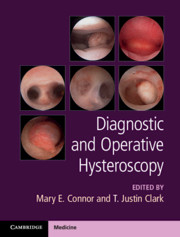Book contents
- Diagnostic and Operative Hysteroscopy
- Diagnostic and Operative Hysteroscopy
- Copyright page
- Dedication
- Contents
- Videos
- Contributors
- Chapter 1 An Introduction to Hysteroscopy
- Chapter 2 Anatomy and Physiology of the Uterus
- Chapter 3 Infrastructure and Instrumentation for Hysteroscopy
- Chapter 4 Diagnostic Hysteroscopy: Accuracy and Interpretation of Findings
- Chapter 5 Hysteroscopy Techniques and Treatment Settings
- Chapter 6 Analgesia and Anaesthesia for Hysteroscopy
- Chapter 7 Indications for Hysteroscopy
- Chapter 8 Hysteroscopic Electrosurgery
- Chapter 9 Complications of Hysteroscopic Surgery
- Chapter 10 Hysteroscopic Endometrial Polypectomy
- Chapter 11 Endometrial Ablation
- Chapter 12 Hysteroscopic Management of Fibroids
- Chapter 13 Hysteroscopic Sterilisation
- Chapter 14 Management of Congenital Uterine and Vaginal Anomalies
- Chapter 15 Hysteroscopic Management of Uterine Adhesions
- Chapter 16 Unusual Hysteroscopic Situations: Caesarean Niche and Retained Placental Tissue
- Chapter 17 Audit, Data Collection and Clinical Governance in Hysteroscopy
- Chapter 18 Training in Hysteroscopic Skills
- Chapter 19 Research and New Developments in Hysteroscopy
- Index
- References
Chapter 2 - Anatomy and Physiology of the Uterus
Published online by Cambridge University Press: 10 September 2020
- Diagnostic and Operative Hysteroscopy
- Diagnostic and Operative Hysteroscopy
- Copyright page
- Dedication
- Contents
- Videos
- Contributors
- Chapter 1 An Introduction to Hysteroscopy
- Chapter 2 Anatomy and Physiology of the Uterus
- Chapter 3 Infrastructure and Instrumentation for Hysteroscopy
- Chapter 4 Diagnostic Hysteroscopy: Accuracy and Interpretation of Findings
- Chapter 5 Hysteroscopy Techniques and Treatment Settings
- Chapter 6 Analgesia and Anaesthesia for Hysteroscopy
- Chapter 7 Indications for Hysteroscopy
- Chapter 8 Hysteroscopic Electrosurgery
- Chapter 9 Complications of Hysteroscopic Surgery
- Chapter 10 Hysteroscopic Endometrial Polypectomy
- Chapter 11 Endometrial Ablation
- Chapter 12 Hysteroscopic Management of Fibroids
- Chapter 13 Hysteroscopic Sterilisation
- Chapter 14 Management of Congenital Uterine and Vaginal Anomalies
- Chapter 15 Hysteroscopic Management of Uterine Adhesions
- Chapter 16 Unusual Hysteroscopic Situations: Caesarean Niche and Retained Placental Tissue
- Chapter 17 Audit, Data Collection and Clinical Governance in Hysteroscopy
- Chapter 18 Training in Hysteroscopic Skills
- Chapter 19 Research and New Developments in Hysteroscopy
- Index
- References
Summary
The uterus is the primary female reproductive organ. It is situated within the pelvis and measures approximately 8 cm in length, 4 cm in width and 5 cm in depth in the normal, non-pregnant state. Though relatively quiescent in pre-pubertal and post-menopausal years, the uterus possesses a variety of functions during a woman’s reproductive years. It responds to the production of female hormones, creating changes to allow for implantation of a fertilised egg, or menstruation when pregnancy does not occur. It is also able to rapidly expand with the development of a pregnancy and has a contractile function for labour and delivery during childbirth [1].
- Type
- Chapter
- Information
- Diagnostic and Operative Hysteroscopy , pp. 6 - 19Publisher: Cambridge University PressPrint publication year: 2020



